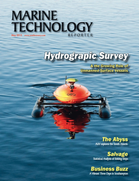Sonardyne Aids NOC
Marine Technology Reporter
Sonardyne International Ltd.’s Ranger 2 USBL acoustic positioning system played a role in the recent discovery of the world’s deepest known undersea volcanic vents by a team from the National Oceanography Center (NOC) in Southampton. The expedition used Ranger 2 to track the Remotely Operated Vehicle (ROV) Isis from the RRS James Cook, 5,000 meters beneath the surface as it recorded video and imagery whilst collecting samples from the newly discovered vents in the Cayman Trough. The expedition, funded by the Natural Environmental Research Council (NERC), saw the researchers, from NOC and the University of Southampton, return to a set of vents – in the Beebe Hydrothermal Vent Field – that they discovered during an expedition in 2010. At the time, these were believed to be the world’s deepest.
Geraint West, Head of NOC’s National Marine Facilities, Sea Systems, which provides ships and submersibles to the U.K. marine science community on behalf of NERC, explained, “The science team and ROV crew came across a further set of vents located even deeper at 4,968 meters, or almost three miles beneath the ocean surface. NOC has used Sonardyne’s positioning systems since the Isis ROV was first commissioned in 2003 and the Ranger 2 system is central to Isis’ precise positioning system. This enabled the ROV to explore this latest discovery; using various sensors and samples, they were able to determine that these vents are among the hottest on the planet, blasting out water at around 401°C.”
www.sonardyne.com
(As published in the May 2013 edition of Marine Technologies - www.seadiscovery.com)

 December 2025
December 2025



